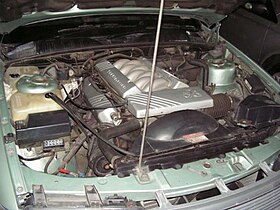| Holden V8 engine | |
|---|---|
 5000i engine installed in a 1990 Calais | |
| Overview | |
| Manufacturer | |
| Production | 1969–2000 |
| Layout | |
| Configuration | Naturally aspirated 90° V8 |
| Displacement |
|
| Cylinder bore |
|
| Piston stroke |
|
| Cylinder block material | Cast iron |
| Cylinder head material | Cast iron |
| Valvetrain | OHV 2 valves per cyl. |
| Combustion | |
| Fuel system | |
| Management | Delco |
| Fuel type | Gasoline |
| Oil system | Wet sump |
| Cooling system | Water-cooled |
| Chronology | |
| Predecessor | GM SBC |
| Successor | GM Generation III LS1 |
The Holden V8 engine, also known colloquially as the Iron Lion engine, is an overhead valve (OHV) V8 engine that was produced by the Australian General Motors subsidiary, Holden (GMH), between 1969 and 2000.
The engine was initially fitted to the Holden HT series in 1969 and was later utilised in a series of updated versions in the Torana and Commodore ranges. The final iteration, the heavily revised HEC 5000i, was phased out of Holden passenger vehicles with the release of the VT Series II Commodore and the WH Statesman and Caprice in June 1999, both of which featured the 5.7L Gen III V8 imported from the United States. However, the engine remained in production for a little while longer and continued to be available in the Commodore VS Series III utility (which sold alongside the VT sedan and wagon as no similar vehicle was available in that range) until the new generation VU Ute debuted in late 2000.
In addition to being Holden's mainstream performance engine throughout its production run, higher performance versions were fitted to limited-edition vehicles available through Holden Dealer Team Special Vehicles (HDT) and later Holden Special Vehicles (HSV). It was also utilised within limited production vehicles from other manufacturers as well as in kit cars.
The engine has a successful history in various forms of motorsport, most notably in the Australian Touring Car Championship and the Bathurst 1000 until 1995, as well as in Formula 5000 and other racing applications.
It can also be found in Australian powerboats fitted with inboard engines, especially those used for water skiing.[1]
- ^ "Holden V8 Conversion Kits & Parts". Cassell Marine. Retrieved 14 October 2020.
